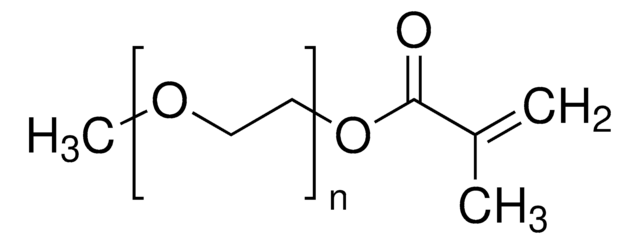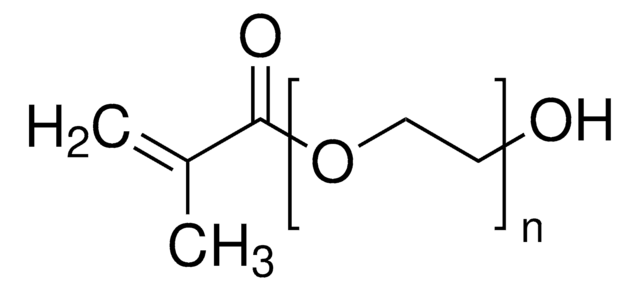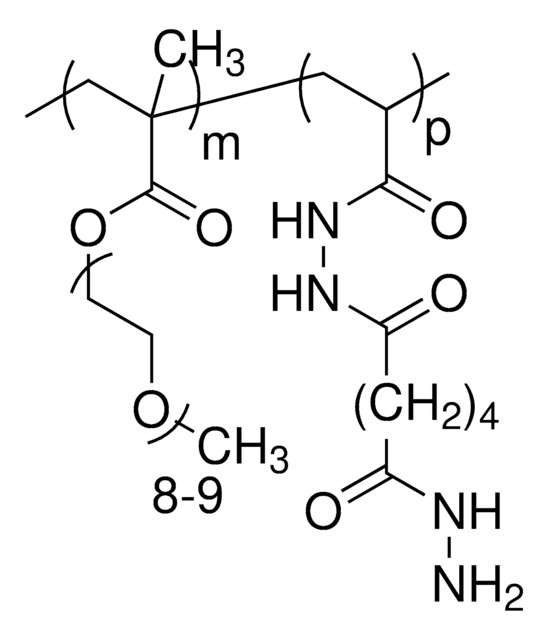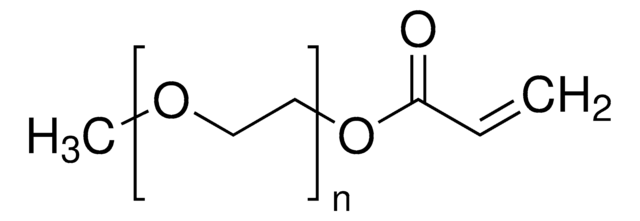930741
Poly(oligoethylene glycol methacrylate)
Synonym(s):
POEGMA, Poly(oligo(ethylene glycol)methacrylate)
Sign Into View Organizational & Contract Pricing
All Photos(1)
About This Item
Linear Formula:
C6H8NO2[C4H5O2(C2H4O)x]nOH
UNSPSC Code:
12352104
NACRES:
NA.21
Recommended Products
General description
Poly(oligo(ethylene glycol) methacrylate) (POEGMA) is a family of polymers consisting of a hydrophobic methacrylate backbone and hydrophilic ethylene oxide (EO) side groups with highly branched architecture. The highly branched architecture with a high density of oligo EO moities enhances the solubility of the polymer in water.
Application
- Drug delivery- enhances the stability and delivery of siRNA and eliminates PEG antigenicity
- Biosensor coatings- provides an anti-fouling surface
- Stimuli-responsive hydrogels for tissue engineering, drug delivery, and other biomedical applications
Poly(oligo(ethylene glycol) methyl ether methacrylate) (POEGMA) is a family of polymers consisting of a hydrophobic methacrylate backbone and hydrophilic ethylene oxide (EO) side groups with highly branched architecture . The side chain EO segments enhance the solubility of the polymer in water , exhibiting many interesting properties such as non-fouling , stealth, anti-PEG antibodies & thermo-responsive behaviors.
Features and Benefits
- Highly branched architecture and high density of oligo ethylene oxide moieties
- Water soluble
- Nonfouling and thermo-responsive behaviors
- Viable alternative to PEG in biological and biomaterial applications
Storage Class Code
10 - Combustible liquids
WGK
WGK 3
Flash Point(F)
Not applicable
Flash Point(C)
Not applicable
Regulatory Information
新产品
Choose from one of the most recent versions:
Certificates of Analysis (COA)
Lot/Batch Number
Don't see the Right Version?
If you require a particular version, you can look up a specific certificate by the Lot or Batch number.
Already Own This Product?
Find documentation for the products that you have recently purchased in the Document Library.
In Pursuit of Zero 2.0: Recent Developments in Nonfouling Polymer Brushes for Immunoassays
Heggestad J., et al.
Advanced Materials, 32 (2020)
Fei Xu et al.
ACS biomaterials science & engineering, 7(9), 4258-4268 (2021-02-12)
Reactive electrospinning is demonstrated as a viable method to create fast-responsive and degradable macroporous thermoresponsive hydrogels based on poly(oligoethylene glycol methacrylate) (POEGMA). Hydrazide- and aldehyde-functionalized POEGMA precursor polymers were coelectrospun to create hydrazone cross-linked nanostructured hydrogels in a single processing
(Co)polymers of oligo(ethylene glycol) methacrylates?temperature-induced aggregation in aqueous solution.
Trzebicka B, et al.
Journal of Polymer Science Part A: Polymer Chemistry, 51, 614?623-614?623 (2013)
Yizhi Qi et al.
Nature biomedical engineering, 1 (2016-01-01)
The delivery of therapeutic peptides and proteins is often challenged by a short half-life, and thus the need for frequent injections that limit efficacy, reduce patient compliance and increase treatment cost. Here, we demonstrate that a single subcutaneous injection of
Rafael Pires-Oliveira et al.
Langmuir : the ACS journal of surfaces and colloids, 36(49), 15018-15029 (2020-12-05)
Understanding of the temperature-induced phase transition of poly(oligo(ethylene glycol) methyl ether methacrylate) (POEGMA) random copolymers with varied composition remains largely incomplete. Upon heating they can form either macroscopically phase-separated aggregates or micelles. We examined the effect of polymer architecture by
Our team of scientists has experience in all areas of research including Life Science, Material Science, Chemical Synthesis, Chromatography, Analytical and many others.
Contact Technical Service




